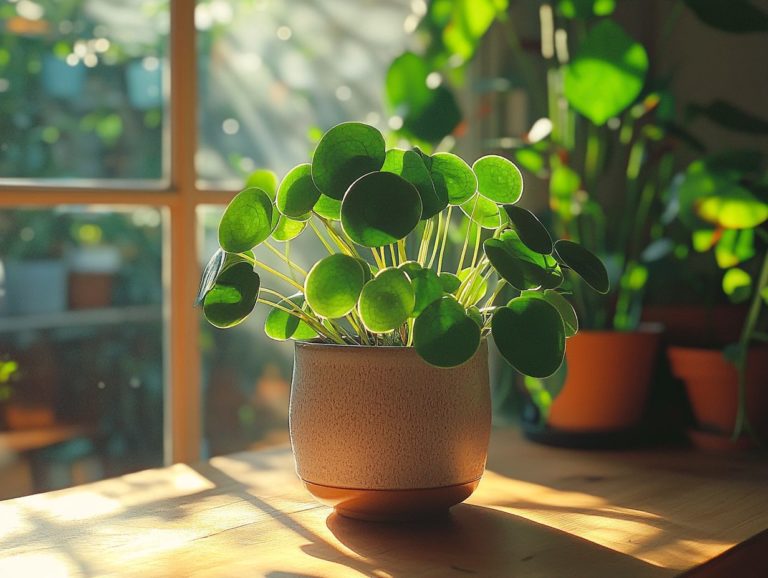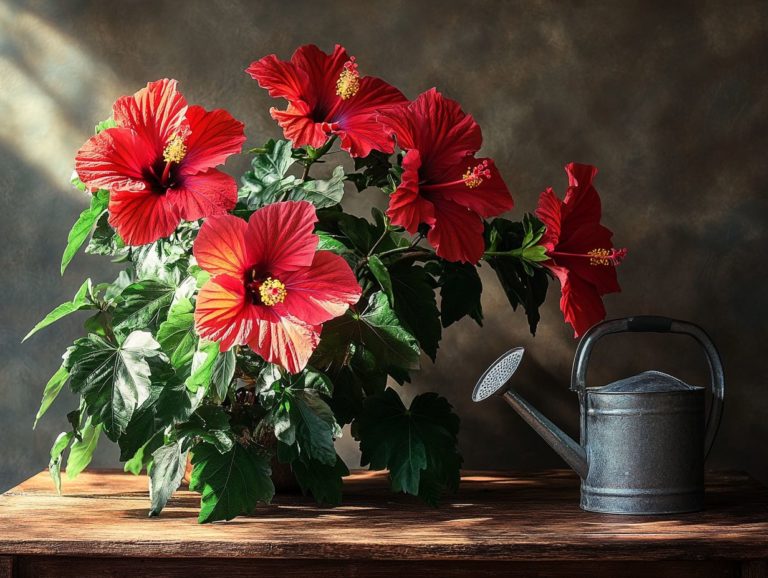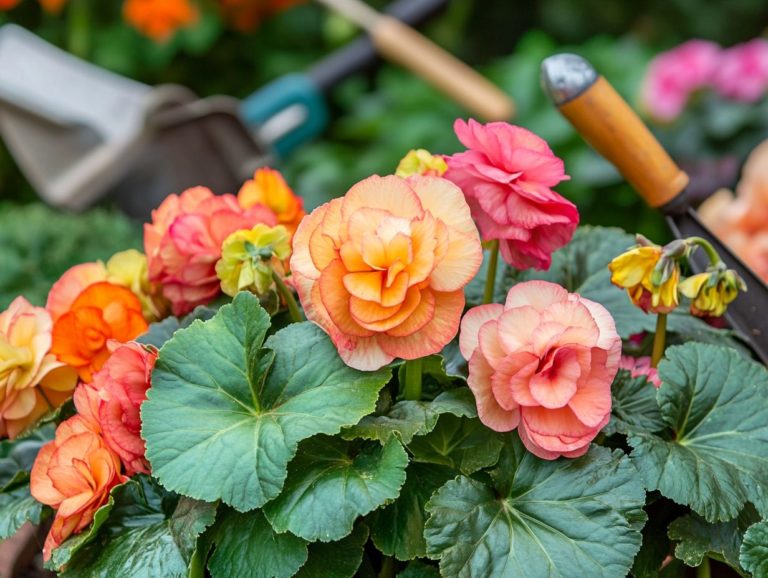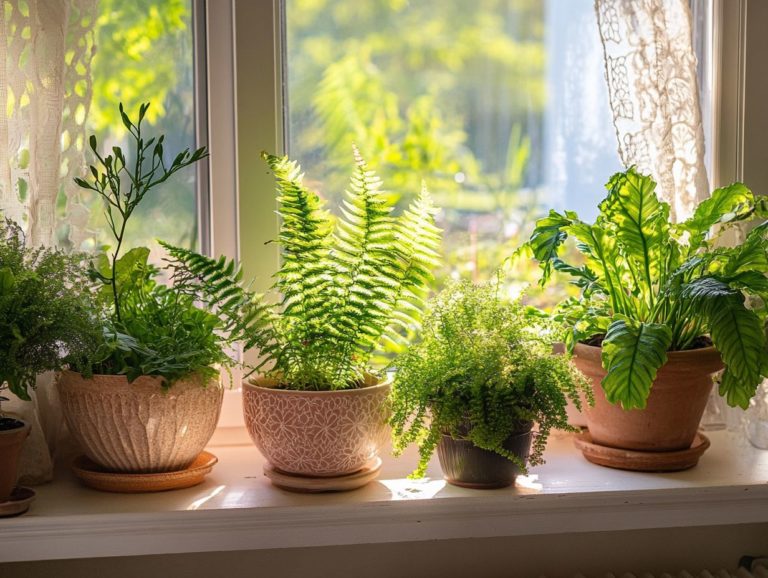Top 5 Indoor Plants for Beginners
Bringing greenery into your home elevates its aesthetic charm while fostering a healthier living space.
Discover the top five indoor plants that are perfect for beginners, featuring the resilient Snake Plant and the effortlessly low-maintenance Pothos.
Uncover the myriad benefits these indoor companions offer, from enhancing air quality to alleviating stress.
Whether you re stepping into the world of plant parenting for the first time or looking to enrich your collection, you’ll gain valuable insights on care and learn to sidestep common pitfalls.
Contents
Key Takeaways:
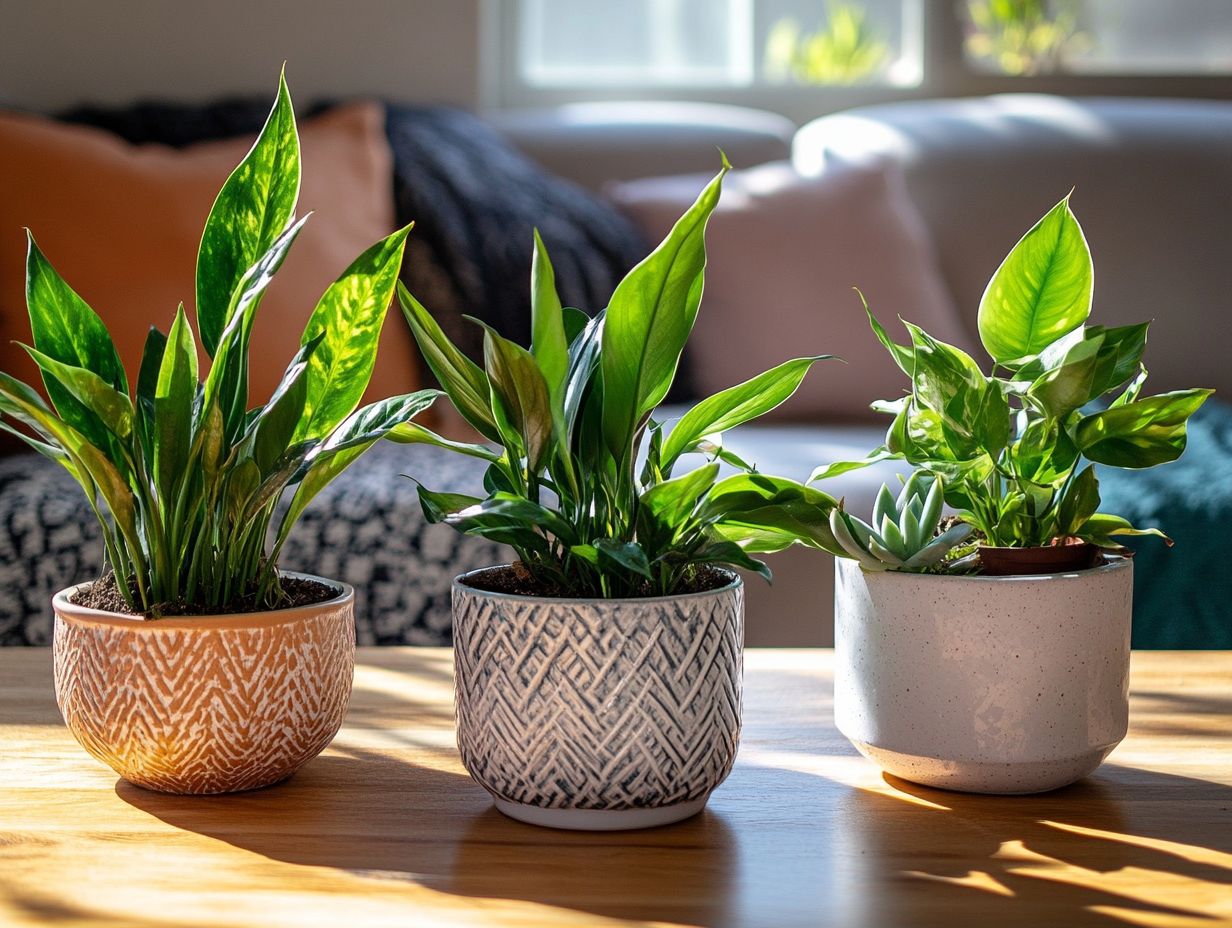
- Start with low-maintenance plants like snake plants and spider plants if you’re new to indoor gardening.
- Pothos and aloe vera are both great options for improving air quality in your home.
- Indoor plants can have a positive impact on mental health by reducing stress and anxiety.
1. Snake Plant
The Snake Plant, or Sansevieria, is a great choice for new houseplant owners.
It’s low maintenance and forgiving, perfect for those who may struggle with plant care.
This hardy beauty thrives in bright, indirect light but is adaptable enough to handle lower light conditions, fitting seamlessly into various nooks of your home.
In terms of watering, remember to let the soil dry out completely between waterings. Overwatering can lead to root rot, a common pitfall for those new to plant care.
Opt for a well-draining potting mix to keep those roots healthy and happy. Experts recommend checking the moisture level by feeling the soil, and in the winter, consider reducing how often you water.
The Snake Plant is not only attractive; it also purifies the air, filtering toxins and improving indoor air quality.
2. Spider Plant
The Spider Plant, with its vibrant green leaves and charmingly arching stems, is truly a standout choice for anyone looking to elevate their indoor gardening game.
It s one of the easiest houseplants to care for, making it perfect for beginner plant parents like you.
This little gem loves bright, indirect light what a treat for your home!
Don’t worry if your space has lower light conditions; it can adapt to various indoor environments.
In terms of watering, simply check if the top inch of the soil feels dry to the touch. Just be cautious not to overwater; we wouldn t want root rot crashing the party.
Growing new plants from a Spider Plant is a breeze. Just snip off the offshoots, affectionately known as pups, and place them in water or directly into soil until they sprout new roots.
Their ability to thrive in diverse environments not only adds to their low-maintenance charm but also boosts your indoor air quality. They filter out airborne toxins, making your living space healthier and more inviting.
3. Pothos
Pothos, often known as Devil’s Ivy, is a must-have in your home, thanks to its stunning foliage and remarkable adaptability.
It s a dream for beginner plant parents seeking low-maintenance houseplants that require minimal effort.
With a delightful array of varieties like Golden Pothos, Marble Queen, and Neon Pothos, these plants can thrive in a wide range of lighting conditions, from bright indirect light to cozy low-light settings.
Their watering needs are refreshingly forgiving; just allow the soil to dry out between watering sessions, and you re good to go.
Not only do Pothos enhance your home decor with their lush greenery, but they also serve a crucial purpose by purifying the air and removing toxins an excellent perk for those who prioritize health.
While new plant parents might encounter common hiccups like overwatering or insufficient light, with a touch of patience, these resilient beauties can flourish, becoming a treasured part of your indoor garden.
4. Aloe Vera
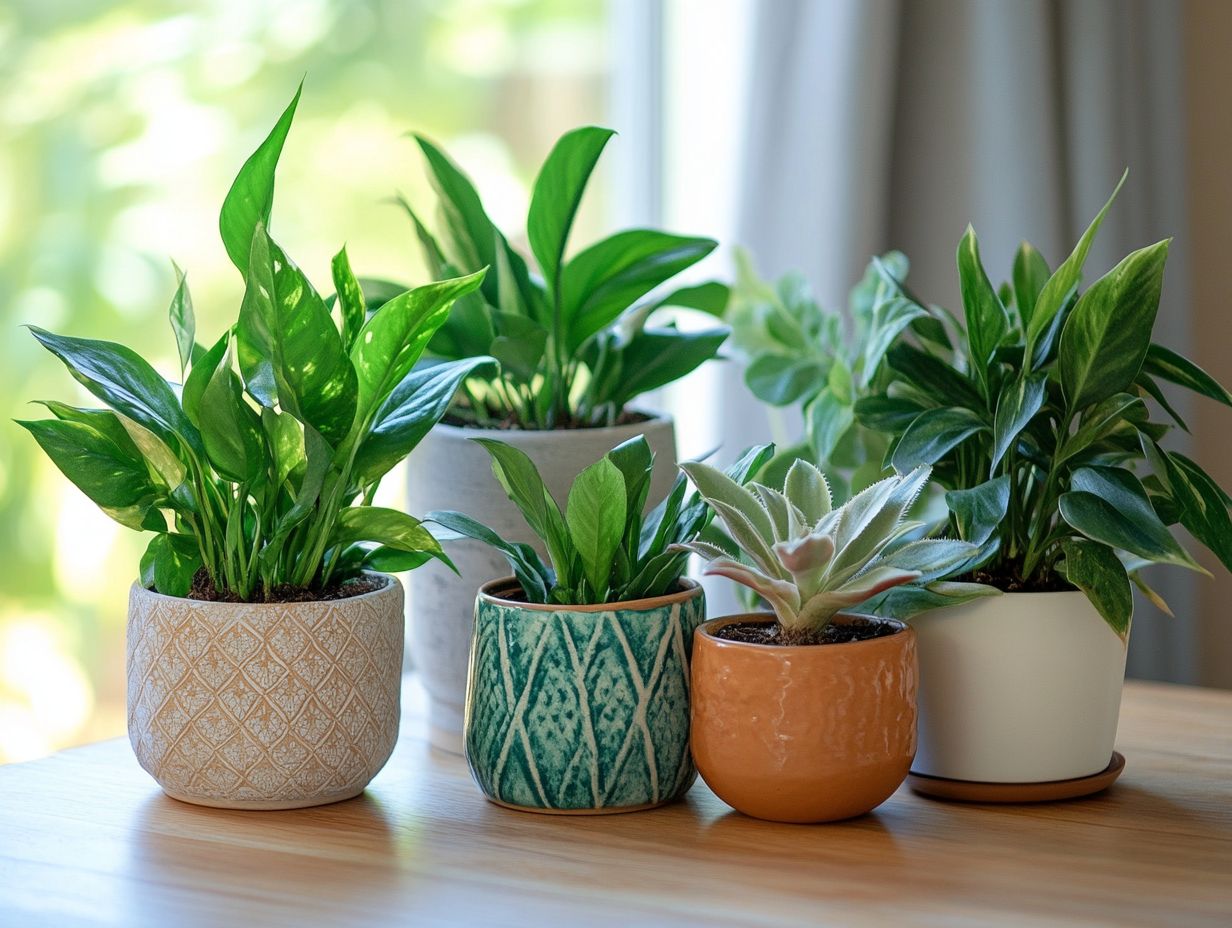
Aloe Vera isn t just another succulent with its soothing gel; it s practically the darling of beginner plant parents. Make it a must-have in any collection focused on easy-care houseplants!
To help this resilient plant grow well, provide it with bright light that doesn t shine directly on the plant just like its natural habitat so those lovely leaves don t end up scorched. Keep an eye on your watering schedule as well, since overwatering can cause root rot.
Allowing the soil to dry out between waterings will keep your Aloe happy and thriving. Aloe Vera also has health benefits; its gel soothes burns and moisturizes skin, making it a practical addition that beautifully balances aesthetics with utility.
5. Peace Lily
The Peace Lily is an exquisite choice for your indoor garden, showcasing striking white blooms and lush green foliage. Its low maintenance requirements make it particularly appealing for those new to plant parenting.
This versatile plant flourishes in low to medium indirect light, making it perfect for less-than-sunny spots in your home. For watering, let the top inch of soil dry out before giving it a drink.
Be careful not to overwater, as it can cause root rot. Regularly check the leaves for dirt buildup, and take a moment to wipe them clean; this small effort helps your Peace Lily absorb more light.
You ll love how the Peace Lily cleans your air while looking stunning in your home! Just remember to keep it out of reach of pets, as the plant can be toxic if ingested.
What Are the Benefits of Having Indoor Plants?
Having indoor plants offers a wealth of benefits that go far beyond mere aesthetics. They can significantly improve air quality, elevate your mood, and foster a connection to the living world around you.
Take the Spider Plant, for example. This remarkable plant excels in air purification, filtering out harmful pollutants while releasing fresh oxygen.
Then there s the Peace Lily, which not only cleanses the air but also brings a touch of elegance with its stunning white blooms. Both of these plants contribute to a heightened sense of mental well-being, helping you feel more relaxed and focused.
Ashley Abramson emphasizes in the New York Times that caring for indoor plants can instill a sense of purpose and joy. Engaging in indoor gardening can also enhance mindfulness, enriching the overall ambiance of your home.
How Do Indoor Plants Help with Air Quality?
Indoor plants are not just a feast for the eyes; they also play a pivotal role in enhancing air quality by filtering out toxins and releasing oxygen. This creates a healthier environment for you and your loved ones.
Among the standout options are the Snake Plant and the Peace Lily. The Snake Plant, often celebrated for its resilience, excels at absorbing formaldehyde and benzene from the air, making it a superb choice for bedrooms and living areas.
The Peace Lily also purifies the air and adds elegance with its blooms. It effectively removes ammonia, xylene, and other harmful pollutants.
Together, these plants harness the power of photosynthesis the way plants use sunlight to create energy and transpiration, elevating indoor air quality. Enjoy a more serene living environment as you breathe easier!
What Are the Best Indoor Plants for Low Light Environments?

For beginner plant parents or those navigating low-light spaces, choosing the right indoor plants is paramount. Consider options like the ZZ plant and snake plant both thrive on minimal sunlight while effortlessly infusing your environment with lush greenery.
These resilient varieties not only demand infrequent watering but are also adaptable to varying moisture in the air, making them wonderfully forgiving companions. Another excellent choice is the Pothos, celebrated for its cascading vines and laid-back demeanor. It thrives in indirect light, making it a must-have for your indoor garden! For more options, consider the top 5 shade-tolerant indoor plants that can brighten up your space.
Then there’s the Peace Lily, a stunning option adorned with elegant white blooms that still shine even in dim settings. For those looking to brighten up their space, explore the top 5 indoor plants for bright spaces. Each of these plants boasts a remarkable tolerance for neglect, offering novice gardeners the reassurance that they can bask in the beauty of indoor greenery without the burden of perfect care.
How Can Indoor Plants Help with Stress and Anxiety?
Indoor plants can significantly lower your stress and anxiety levels, creating a calming atmosphere that enhances your overall well-being simply through their presence and the nurturing experience they offer.
Researchers in the Journal of Environmental Psychology found that nurturing plants like Pothos and Peace Lily leads to measurable improvements in mental health. Interacting with greenery can boost your mood and even alleviate feelings of depression. For those with northern windows, incorporating the top 5 plants for northern windows can provide vibrant foliage that not only enhances your space aesthetically but also purifies the air, contributing to better emotional health.
The soothing ritual of watering and caring for these resilient plants is therapeutic, providing you with a moment of mindfulness that can be truly invaluable in today s fast-paced world.
What Are Some Tips for Caring for Indoor Plants?
Caring for indoor plants involves understanding their unique needs. With a few expert tips, you can successfully nurture your green companions and elevate your indoor gardening experience.
Deciphering sunlight requirements and mastering the art of watering are essential skills that will be pivotal in fostering a thriving indoor garden. For instance, positioning your plants near east-facing windows often provides the ideal morning light, while south-facing windows can offer intense sunlight throughout the day.
Professionals suggest recognizing each plant’s specific watering needs remember, overwatering can be just as harmful as underwatering. Using well-draining soil can significantly enhance moisture retention while allowing excess water to escape, creating the perfect environment for healthy root development.
What Are Some Common Mistakes to Avoid When Caring for Indoor Plants?
Newbie indoor gardeners often find themselves on a steep learning curve, grappling with common missteps like overwatering, inadequate lighting, and neglecting soil drainage. These mistakes can significantly hinder the growth of your cherished plants.
Grasping the fundamentals of plant care is essential to navigate these pitfalls successfully. Many beginners underestimate the importance of selecting the right potting mix and drainage solutions, which can lead to issues like root rot or stunted growth. Additionally, understanding the top indoor plants for varied lighting can greatly enhance your success in indoor gardening.
Experts suggest using a well-aerated soil blend and ensuring that your pots have drainage holes. It’s easy to overlook the specific light requirements of each plant, which may result in either scorched leaves or leggy growth. For beginners looking to choose the right plants, check out the top indoor plants and their soil needs.
A straightforward solution is to research each plant s unique needs and adjust their placements accordingly. By integrating these insights, you can elevate your indoor gardening experience from a frustrating challenge to a thriving oasis of greenery.
Frequently Asked Questions
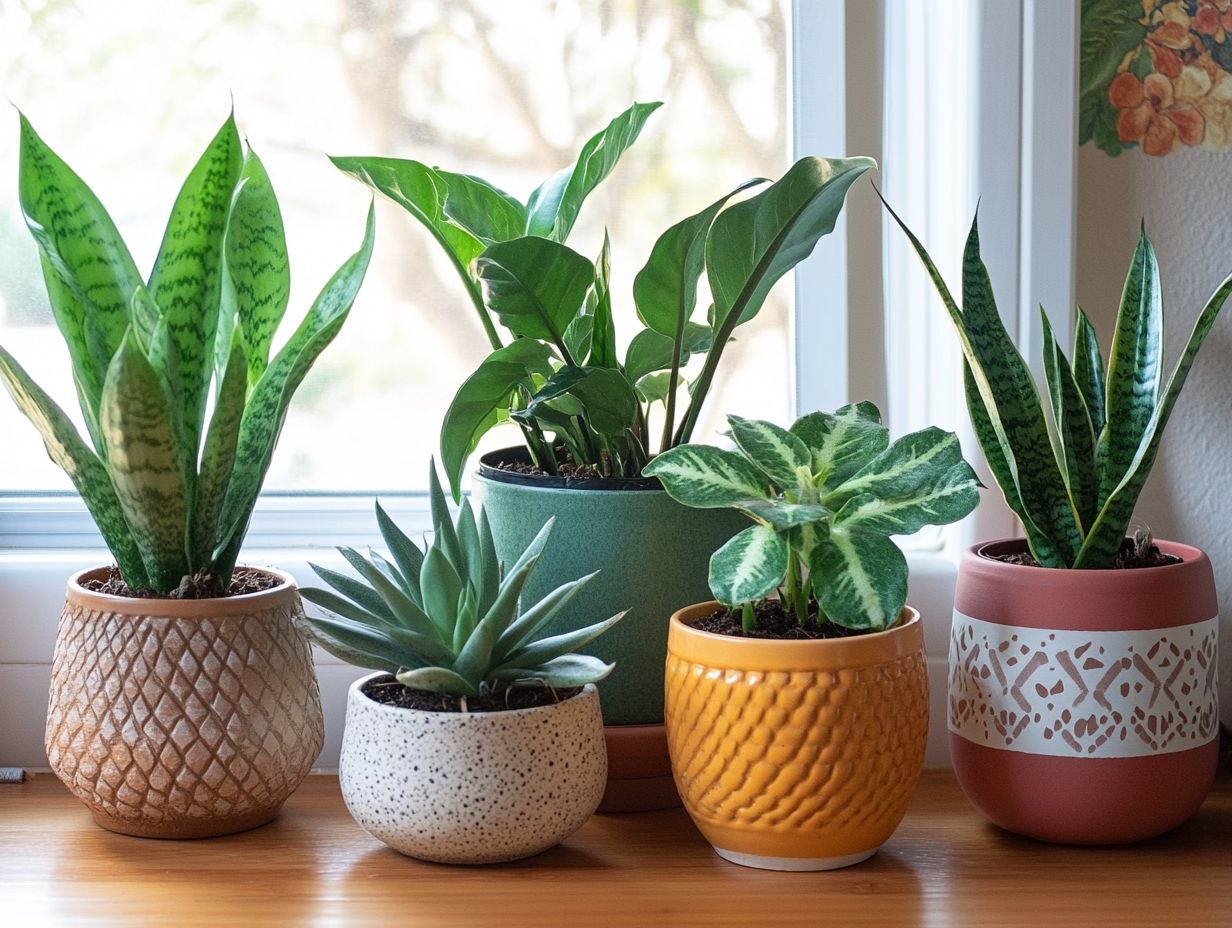
1. What are the top 5 indoor plants for beginners?
The top 5 indoor plants for beginners are spider plant, Pothos, snake plant, Peace Lily, and succulents.
2. How do I care for a spider plant?
Spider plants are low maintenance and prefer bright, indirect light. Water them once a week, and ensure the soil drains well!
3. Can I grow pothos in low light conditions?
Yes! Pothos can grow well in low light but will flourish faster in bright, indirect light.
4. What is the best way to care for a snake plant?
Snake plants survive in low light and need very little water. Let the top inch of soil dry out before you water again!
5. How often should I water a peace lily?
Peace lilies like their soil to be consistently moist. Water them once a week, and they ll thrive in low to medium light.
6. Are succulents good for beginners?
Absolutely! Succulents are perfect for beginners since they require minimal care and adapt to various lighting conditions. Just remember don t overwater them!

